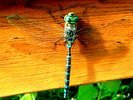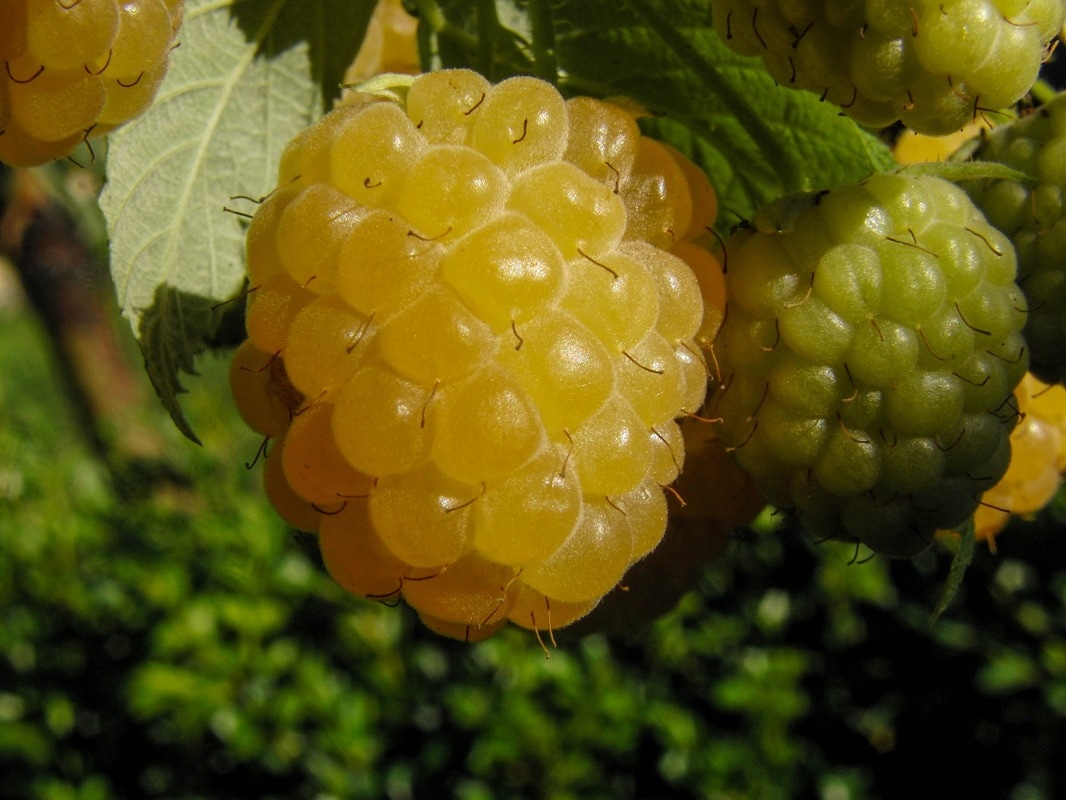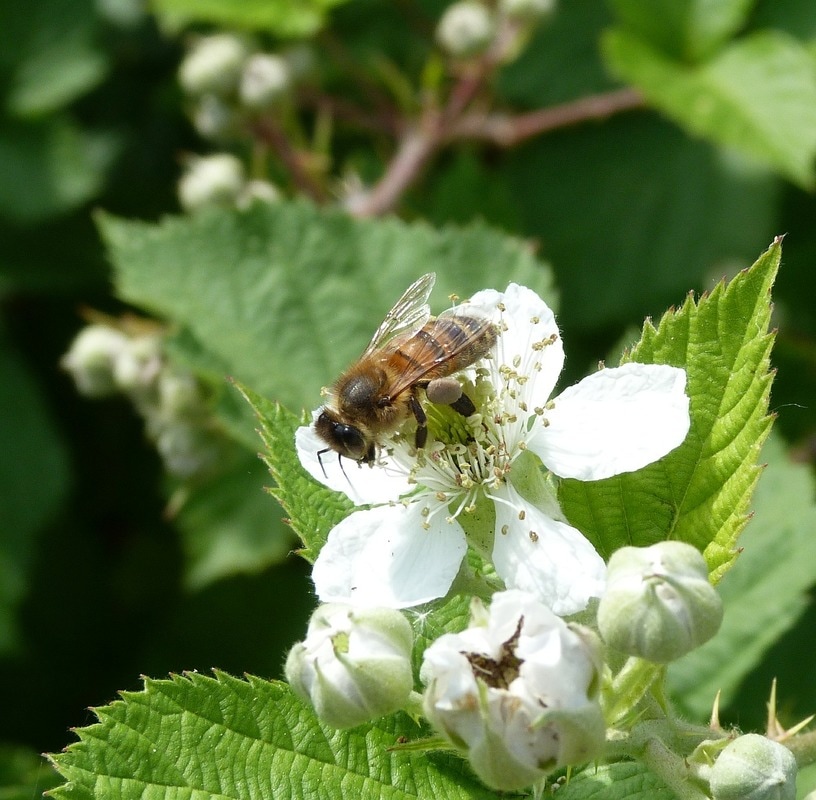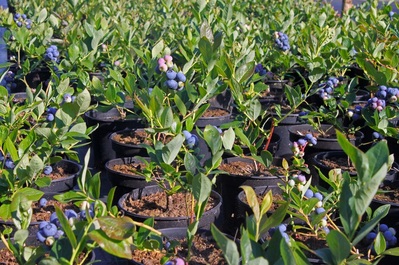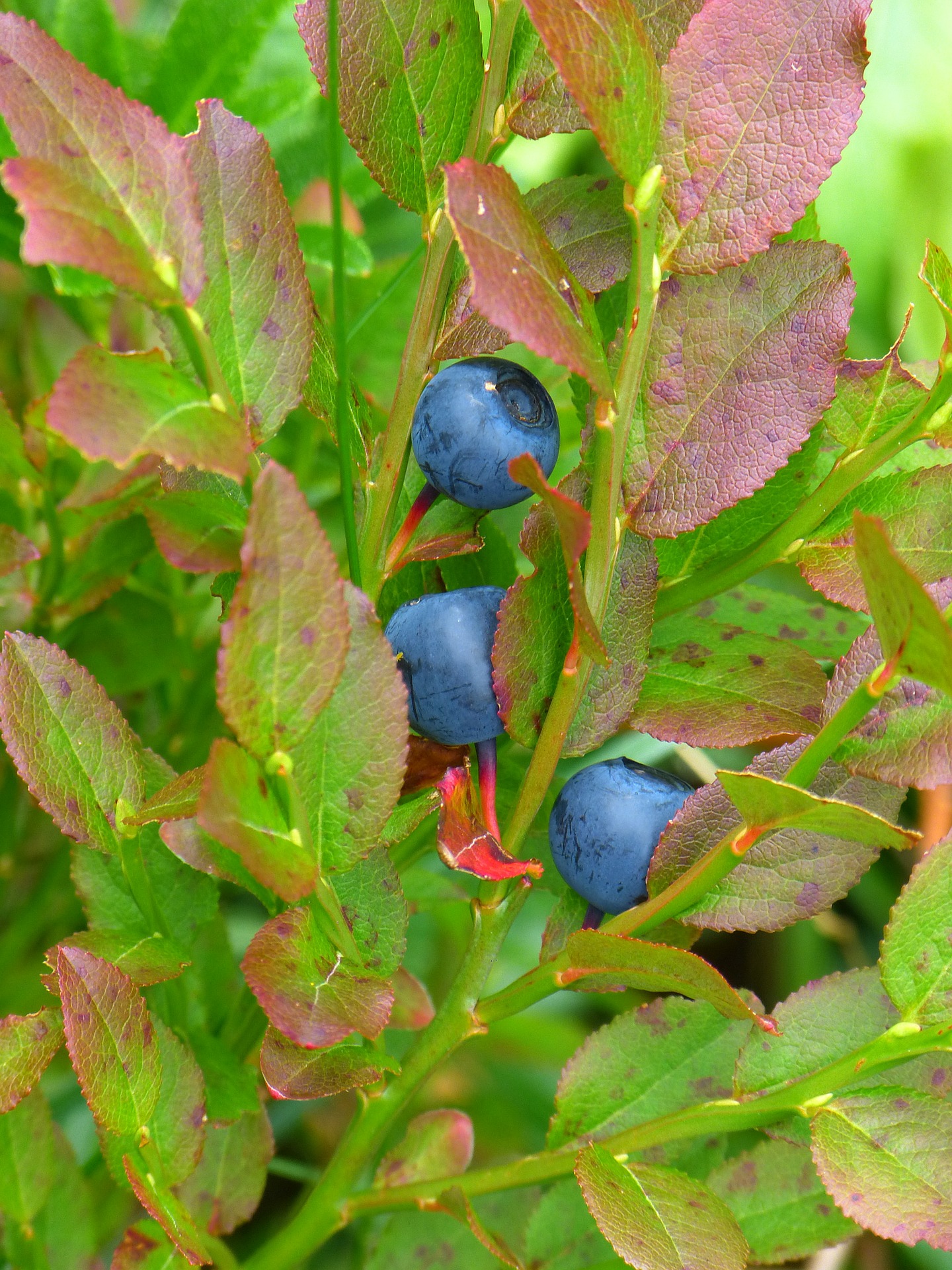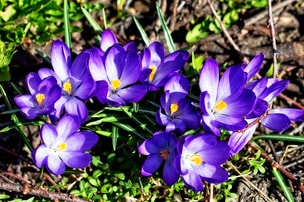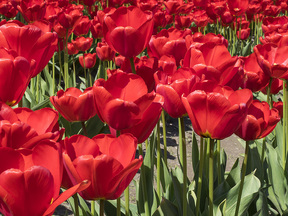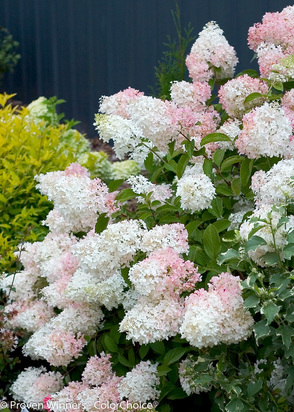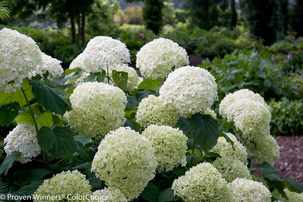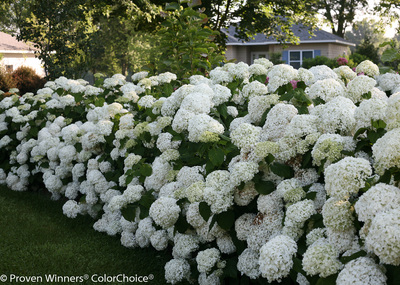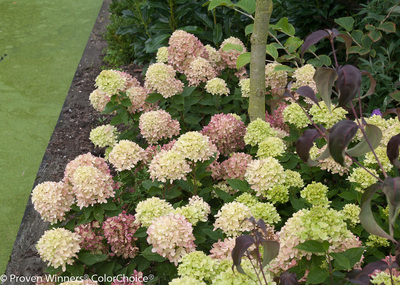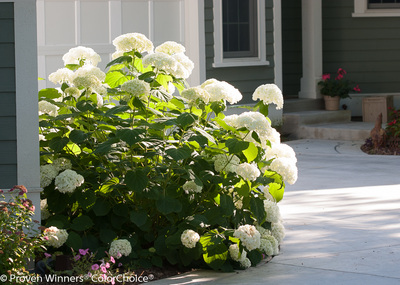HASKAP |
The haskap species lonicera caerulea is native to the northern boreal forests of Asia, Europe and North America, usually found growing in high mountains or low lying wet areas. Historical use of haskap dates back centuries to the people of Hokkaido Island, Japan.
In the 1950’s, Siberian horticulturists collected wild samples and began breeding haskap. Haskap remained relatively unknown in North America until the late 1990’s when tasty cultivars began getting attention. In 1998, the University of Saskatchewan launched its own haskap breeding program. To date, U of S has produced some of the best varieties in the world.
Select a planting site that receives 6+ hours of daily sun.
Decide how many plants you want. If you want to grow them as a hedge, space plants 3-4’ apart. If you want freestanding shrubs, space them 4-5’ apart.
Haskap are far more adaptable to wet soils and a broad pH range than most other fruits, though their preference is well-drained, somewhat acidic soil. Soil fertility is important so definitely add 2-6 inches of compost or manure to your garden soil. Adding several inches of peat moss is recommended too.
Ask your local garden centre if you have any specific concerns regarding your garden soil.
Haskap are usually available as early as mid-April. For the first few weeks, either
1. Keep them in a greenhouse, or
2. "Harden them off" (put them outside during the day but bring them inside at night)
By early May, it is normally safe to leave them outside.
Haskap are often available later and can be planted at any time in the growing season.
Ensure that you’re getting not only two different varieties, but two varieties which are compatible for pollination. Otherwise, no fruit for you! One variety is sometimes considered more desirable (i.e. – has better flavour, size) while the companion/pollinizer variety is primarily meant to help the desirable variety set fruit. The companion variety will still produce fruit.
If you want several haskap bushes, plant 1 pollinizer variety to every 6 of the desired variety plants.
To simplify things, growers often sell a single pot with two compatible varieties in it. If you’re buying individually potted varieties, check the plant tag for the recommended pollination pairing.
Haskap Varieties
Haskap flavour can vary from sweet to bitter to….awful. Fortunately, breeders have worked hard to improve flavour over the last few decades. When picking a variety, the main factors to consider are berry flavour, firmness and size. Many of the varieties available in Canada are Siberian/Canadian introductions released by the University of Saskatchewan.
- Tundra: Exceptionally firm and large berries with a melt-in-your-mouth texture and a high flavour ranking. Grows 4-5’ tall. Excellent for fresh eating, jams/jellies and wine. Pollinate with Honeybee or other recommended variety
- Borealis: Sweet and tangy but softer than Tundra. Often considered the best tasting variety. Grows 4’ tall. Pair with Polar Jewel, Aurora or other recommended variety
- Aurora: Slightly sweeter, larger, more productive and easier to pick than Borealis. Grows 5’ tall. Pair with Borealis, Tundra, or Indigo
- Polar Jewel: Sweet, deep blue berries. Eat fresh or use in baked goods, jams, and jellies. Pair with Tundra or Borealis
- Honeybee: Tall plant produces large, tart blue fruit. Use for making wine, juice, and jellies. Pair with Borealis or Tundra
So you've prepared the planting site and you've got your haskap bushes. Now space your haskap appropriately (refer back to the Before You Plant section if needed).
Water both the plant and the planting hole deeply. Add a handful of bone meal or other similar fertilizer at planting time. Haskap can be planted slightly recessed (1-2” below ground level). Once the bushes are in the ground add 2-4" of bark mulch or rotted sawdust. This will help keep the roots cool and moist. Water the plants once more.
Refer to our Guide to Planting Shrubs for further transplanting instructions.
Since haskap is shallow-rooted, it is critical that the soil never dries out. Water the haskap deeply and infrequently (about once per week), especially during the first few years of growth.
In subsequent seasons, you may need to add more organic matter to maintain the soil's richness.
Haskap does not sucker and needs minimal yearly pruning. In early spring, thin out some of the old branches to maintain air circulation and vigorous growth.
Allow haskap to fully ripen before harvesting – under ripe berries are not pleasant. Ripe berries will have a purple interior.
Ripe berries can even remain edible if they are left on the bushes for several weeks.
Haskap is commonly used to make:
- Wines
- Juices
- Ice creams
- Smoothies
- Sauces and jams
- Baking sweets
Haskap is:
- Incredibly hardy, rarely affected by cool springs or harsh winters
- Compact, requiring very little pruning
- Thornless
- Rarely affected by pests or diseases
- Early ripening (up to 2 weeks before strawberries)
- Heavily productive
- A recognized superfood – loaded with anti-oxidants, fiber and Vitamin C
- One of the few northern fruits that make excellent wine
I’d say that’s a compelling case for growing haskap.
For further reading, check out Haskap Canada page or the University of Saskatchewan’s haskap page.
 Who doesn’t love the sweet flavour and melt-in-your-mouth texture of raspberries? Silly question.....everyone does! Thanks to their delightful taste and easy growing nature, raspberries are very common to northern gardens. Raspberries are vigorous, sprawling plants with few disease and pest problems. Their flowers are also an important nectar source for honeybees and other pollinating insects. Red raspberries are the most commonly cultivated but yellow, black and purple types are available. Yellow raspberries are genetically identical to red raspberries except that they lack the red color pigment. Black and purple raspberries are an entirely different story. This article specifically covers red and yellow raspberries. | Find a gardening topic using the search bar. Categories All |
RASPBERRIES
At a Glance
SOIL NEEDS Organic, moist, well-drained
MATURE PLANT SIZE 3-6’ tall and 2-3’ wide, depending on variety
SPACING 2-3' between plants; 8-10' between rows
GROWTH RATE Fast
LIFE SPAN 10 years or more
FRUITING TIME July through September depending on the variety
EXPECTED YIELDS Varies widely; around 2-3 lbs per bush
POLLINATION NEEDS Self-pollinating
PRUNING REQUIRED Annually
PROVEN PERFORMER Nova, Boyne, Killarney, Latham
VARIETIES
Select a planting site that receives 6+ hours of daily sun.
Raspberries are best planted in rows with open space for berry picking on both sides. Against a fence or a building is the second best option. Each plant needs 2-3 feet of space within the row. If you want multiple rows, leave 8-10 feet between rows.
Like most fruits, soil quality largely determines the resulting berry flavour, yields, and general plant health. Raspberries like sandy, moist, and fertile soil. Plants grown in clay soils tend to suffer root rot and contract diseases that shorten their life span.
If your soil doesn't fit the ideal profile, don't despair! Some basic soil amending is all that is needed. Incorporate two to six inches of compost or manure to improve soil fertility and help retain water. Peat moss is another useful soil conditioner, as it regulates moisture in both sandy and clay soils.
If you have heavy clay soil, consider growing raspberries in a raised or mounded bed.
Ask your local garden centre if you have any specific concerns regarding your garden soil.
When to Plant
| Raspberry canes are usually available as early as mid-April. For the first few weeks, either 1. Keep them in a greenhouse, or 2. "Harden them off" (put them outside during the day but bring them inside at night) By early May, it is normally safe to leave them outside. Keep some frost cover or old sheets at the ready just in case a heavy frost or snow is expected. Potted raspberry bushes are often available throughout the growing season. |
| Buying Raspberry Bushes Before buying raspberry bushes, consider what features are most important to you. Is it berry flavour? Proven cold hardiness? High yields? Harvest time? Whatever features are most important to you will guide you to your ideal variety choice. At this point, it’s also useful to understand how summer-bearing and everbearing (fall-bearing) varieties differ. |
With raspberries, the roots and crowns are perennial but their shoots (above ground growth) may be annual or biennial.
All summer-bearing raspberries are biennial: they need two seasons to complete their life cycle (to grow, fruit, and then die). Without getting into further complexities, suffice to say that this produces one large raspberry crop in early summer. Summer-bearers usually fruit for a few weeks.
All everbearing raspberries have a mixture of biennial and annual canes. The earliest shoots to emerge in spring will fruit that same fall; the later emerging shoots won't produce fruit until the following summer. The result is two crops of raspberries: a small crop in early summer and a large crop in fall.
The drawback to everbearing raspberries is that the larger crop usually ripens in late summer, when frost may damage the harvest. Therefore the yields are often smaller versus summer-bearers. However, their advantage is that they fruit for longer duration.
Raspberry Varieties
Berry production, fruit quality, hardiness and ripening time can greatly vary between cultivars. To extend the harvest period, consider getting a few varieties with different ripening times.
Also see the Proven Performer Varieties listed at the top of the page, in the Growing Raspberries Overview section.
Summer-bearing Varieties to Consider
| Summer-bearing raspberries produce fruit over several weeks, starting in July. Here are some summer-bearing varieties to consider:
|
Everbearing varieties generally fruit later than summer-bearing varieties. They can potentially producing a summer crop and a fall crop BUT in our climate, they are best treated just as a late season producer (see #5 on the Post-Planting Care, below, for more details).
Here are some everbearing varieties to consider:
|
Note* - If you’re buying bare-root raspberries, there may be additional instructions, such as soaking the roots before planting.
Now that you've prepared the planting site and got your raspberry bushes (refer back to the Before You Plant section if needed), lay out your plants.
Water the raspberry plants and planting holes deeply. Add a handful of bone meal or other similar fertilizer. Once the canes are in the ground, consider adding 2" of bark mulch, sawdust, leaves or lawn clippings around the base of the plants. This helps to retain moisture while suppressing weeds. Water the plants once more.
Install support posts or stakes at this time to avoid disturbing the root system later. Check out gardening books or online sources for support ideas; there are dozens of variations.
Raspberries grow with such incredible vigour that it’s hard to believe that they need any attention. However, you’ll notice huge differences in berry quality, production and general plant health with just a bit of routine care.
- Water deeply and infrequently - about once per week. Watering is most critical during the fruit development stages (bloom time to harvest).
- Eliminate competition - Keep weeds away from the base of plants by mulching and/or weeding
- Feed annually - With a granular berry fertilizer, all-purpose fertilizer or other balanced fertilizer
- Enrich soil - Add organic matter (compost or manure) annually or as needed to maintain soil fertility
- Prune - Raspberries require yearly pruning to prevent disease and keep growth in check. In fall, prune out all canes that bore fruit (to a few inches above ground level). In spring, thin the canes so that there are 4-6 canes per linear foot. Remove any weak or dead cane tips. Do not allow rows to grow beyond 12-18” wide.
Raspberries are excellent for fresh eating, freezing, or preserving. Here are some serving suggestions:
- Sprinkle fresh raspberries on top of salads, yogurt, ice cream, or chocolate desserts
- Add frozen raspberries to smoothies (freeze on cookie sheets before bagging)
- Cook into jams or syrups
- Make juice
| Blueberries are tasty little gems, packed with nutrition and a wide range of health benefits. Lucky for us, they are also well suited to growing in north-central British Columbia's climate. This is because our soils tend to be slightly acidic, the summers are relatively cool, and rainfall is common. | Find a gardening topic using the search bar. Categories All |
BLUEBERRIES
At a Glance
SOIL NEEDS Organic, moist, well-drained, and very acidic
MATURE PLANT SIZE 1-4' high & wide, depending on variety
GROWTH RATE Slow
LIFE SPAN 40 years or more
FRUITING TIME July or August, depending on the variety
EXPECTED YIELDS 5-9 lbs per bush
POLLINATION NEEDS 2 varieties minimum for best production
PRUNING REQUIRED Annually
PROVEN PERFORMER Northblue, Northcountry, Patriot, Chippewa
VARIETIES
Proper soil preparation is key to maximizing berry production and overall plant performance.
First, choose a planting site that receives 6+ hours of daily sun. Decide roughly how many plants you want. (Required spacing between plants is 2-4' feet.)
If your soil doesn't fit the ideal profile for blueberries (and it probably won't) the soil will need amending. Blueberries thrive in exceptionally acidic, moist, rich, well-drained soils. Generally speaking, most gardens will require:
- Adding four to six inches of peat moss to increase soil acidity and regulate water retention
- Adding two to six inches of garden compost, mushroom compost, and/or well-rotted manure to improve soil fertility and water retention
Ask your local garden centre if you have any specific concerns regarding your garden soil.
| When to Plant Blueberries are usually available as early as mid-April. For the first few weeks, either
Blueberry bushes are often available throughout the growing season. |
Not all blueberries are created equal. Before buying blueberry bushes, decide what features are most important to you. Is it berry size? Berry flavour? Proven cold hardiness? High yields? Whatever feature(s) are most important to you will guide you to your ideal variety choice.
| For best fruit set, you'll actually require two or more different varieties with the same or overlapping bloom times. You can pair an early season variety with a mid season variety, a mid season variety with a late season variety. Basically, any pollination pairing will work except for an early season with a late season variety. |
Blueberries are also classified according to their bush height: low-bush, half-high, and high-bush. The half-high varieties tend to be the hardiest of the bunch.
Also see the Proven Performer Varieties listed at the top of the page, in the Growing Blueberries Overview section.
Half-High Varieties to Consider
- Chippewa: A reliable producer of sweet, large, firm sky-blue berries. Grows 3-5' high and wide. A mid-season variety
- Northblue: Perhaps the highest yielding variety for our area; berries are large, sweet, firm, and dark blue. Grows 3-4' high and wide. A mid-season variety
- Northcountry: Produces an abundance of small to medium, sweet, mild sky blue berries. Grows 2-4' high and wide. A mid-season variety
- Northland: A small to medium sized, dark blue berry with wild blueberry flavour. Grows up to 4' high and wide. A mid to late season variety
- St. Cloud: A high yielding variety with medium sized, firm, flavourful, dark blue berries. Excellent for fresh eating. Grows 4' high and wide. An early season variety
- Patriot: A hardy, reliable producer of sweet, large berries. Grows 3-4' high. An early season variety
- Duke: A high-yielding variety producing large, mild-tasting berries. Grows 4' high and wide. An early season variety
- Reka: A high-yielding variety that produces medium sized, tasty, firm blue fruit. Grows 4' high and wide. An early-season variety
- Bluecrop: Produces large, sweet, mild tasting berries. Grows 4' high and wide. A mid-season variety
- Chandler: Produces the largest sized blueberries in the world! Grows 4' high and wide. A late-season variety that produces over many weeks
Novelty Varieties to Consider
- Razz: developed in the 1930's but remained obscure because of its unsuitability for commercial production. Large, powder blue berries have a unique raspberry flavor. Grows 3-4' high. A mid-season variety.
- Pink Popcorn: Introduced in 2014, this variety produces high yields of medium sized pink berries with the typical blueberry flavour. Grows 3-4' high. A mid season variety.
Planting Time
So you've prepared the planting site and you've got your blueberry bushes (refer back to the Before You Plant section if needed). Next, space your blueberries appropriately. Spacing will range between 2-4', depending on which varieties you've selected.
Water both the blueberry plant and the planting hole deeply. Add a handful of bone meal or other similar fertilizer at planting time. Once the bushes are in the ground add 2-4" of bark mulch, sawdust, or pine needles on top. This will help to acidify the soil and keep the roots cool and moist. Water the plants once more.
Refer to our Guide to Planting Shrubs for further transplanting instructions.
Caring for Blueberries After Planting
Since blueberries are shallow-rooted plants it is critical that their soil never dries out. Water the blueberries deeply and infrequently (about once per week), especially during the first few years of growth.
Also, prune off all flowers for the first 2 years so that the plant to devote all of its energy to establishing a healthy foundation of roots and leaves. A bigger, sturdier bush will produce significantly larger yields for decades to come.
Keeping Established Blueberries Happy
In subsequent seasons, you may need to add more organic matter to maintain the soil's richness and acidity. An annual application of fertilizer in early spring is also a good idea. Use a formula specifically recommended for acid-loving plants or berries. Organic fertilizer options include blood meal, bone meal, kelp, or fish fertilizer.
Since blueberries only bear fruit on one-year old wood, established plants need an annual spring pruning. For pruning instructions, visit the University of Minnesota's blueberry page here.
Eating the Harvest
Blueberries are a versatile crop. They are delicious fresh, frozen, baked, or preserved. Here are a few serving suggestions:
- Sprinkle fresh blueberries onto salads, yogurt, oatmeal, or pancakes
- Freeze them for smoothies
- Make jams and jellies
- Bake them into muffins or pies
| Summary Blueberries are one of the easiest berries to grow in our climate. They are hardy, long-lived, and disease resistant. As ornamental shrubs, they aren't slouches either; their stunning fall colors range from coral to orange to red. For further reading, check out the University of Minnesota's page on Blueberries for the Home Gardener. U of M is an authority on the topic as they have bred many of the half-high blueberry varieties currently on the market. |
| 1. What are fall bulbs? Fall bulbs are bulbs which must be planted in Fall. This is because they require a lengthy “chilling period” (winter) in order to grow and bloom. Most (but not all) fall bulbs actually bloom in Spring. For this reason, the terms fall bulbs and spring-blooming bulbs are often used interchangeably. You’re probably familiar with many fall bulbs; crocuses, daffodils, and tulips are just a few examples. | Find a gardening topic using the search bar. Categories All |
| 2. Why plant fall bulbs? I love fall bulbs….and I can hardly wait to tell you why! You know that time of year when winter is ending but the landscape is mostly brown and lifeless? And every day you’re anxiously awaiting more signs of spring? Well, it’s those fall bulbs that step in to beautifully to take the edge off. Simply seeing these harbingers of spring makes me incredibly happy. Fall bulbs are also:
|
Fall bulbs should be planted between mid-September and late October, and no earlier. In fact, they can be planted even later, so long as you can stick a spade in the ground.
4. Can I plant them in spring instead?
The short answer to this is no. You’ll see a few potted tulips, daffodils, or grape hyacinth available in spring but selection is very slim. Moreover, you’re paying a much higher price per bulb.
5. Where should I plant fall bulbs?
The #1 Rule is to plant fall bulbs in well-drained soil. They will rot in heavy, clay, or boggy soils.
Otherwise, fall bulbs can be planted just about anywhere in the ground. Intersperse them throughout your perennial gardens, add them to your annual beds, or plant them around the base of deciduous shrubs or trees.
Planting Tip: Most bulb leaves go yellow once the bulb has bloomed. It’s tempting to cut down this unsightly foliage but DON’T do it! Bulbs need these leaves to gather energy for the next season’s growth.
Instead, strategically plant bulbs near slower-to-emerge plants that will later hide the yellow bulb foliage.
6. When do fall bulbs bloom?
Bloom times vary; some bloom as early as March (in some years) and others bloom into late May. Bulbs are generally categorized as early, mid, or late spring bloomers.
| 7. Can I plant them in sun or shade? Fall bulbs grow best in full to part sun. The earliest bulbs will bloom before most trees and shrubs leaf out, so even areas that are normally shaded may be suitable for the early bloomers. Bulbs need a minimum of 4 hours filtered sunlight per day. In such areas, try Siberian Squill, Glory of the Snow, Snowdrops, Fritillaria, Crocuses, or Grape Hyacinth. |
| 8. How many should I plant? Grouping Guidelines:
Plant bulbs in irregular groupings for the most aesthetically pleasing effect. Bulbs are often packaged to work with these guidelines. |
Recommended planting depths and bulb spacing are normally printed on every package. A good rule of thumb is to plant small bulbs 4 inches deep and mid/large bulbs 6 inches deep.
10. Which bulbs are best for our region?
There are many perennial bulbs suited for our region, some longer-lived than others:
- Botanical Tulips
- Crocuses
- Daffodils
- Fritillaria
- Glory of the Snow
- Grape Hyacinth
- Hyacinth
- Hybrid Tulips
- Ornamental Onion
- Siberian Squill
- Snowdrop
In Summary
If you weren’t already convinced about the virtues of fall bulbs, I hope you are by now.
In my humble opinion, they are tragically underutilized in gardens and I’m passionate about changing that. When people see tulips or daffodils in spring, they want them in their garden too; they just simply aren’t aware that the planting process starts in fall.
I encourage you to experiment with fall bulbs this season. Shop for a variety of bulbs in colors you love. Grab a travel mug of coffee or tea and get in your garden on a cool, crisp fall day. As you turn over the dirt, making space for your little gems, think about how cheerful and welcoming they will be in 6 months. You can thank yourself now and you’ll certainly thank yourself later.
| Novelty edibles are a great way to inject excitement into your edible garden. The entire process, from selecting, to growing, to harvesting the plant, is rife with anticipation. What will the plant look like? What will the fruit look like? What will the fruit taste like? How will it combine with other foods? Basically, you're taking yourself on an extended growing/culinary adventure full of discovery and sensory stimulation. And hopefully, you're taking your kids, spouse, and friends along with you. These seven edibles are all visually fascinating and incredibly flavorful. "Acquiring a taste" for them is not necessary; they are widely considered to be delicious. None of them require fancy or unfamiliar preparations either, and yet they will elevate your meals to a gourmet status. Most of them can be enjoyed raw without any processing whatsoever. Always an important factor for us Northern gardeners is plant performance. These edibles all have short maturity times and can be grown in containers or in the ground, If you want something extra special in your garden this spring, consider the novelty recommendations below. Whether you're a child or not, these curiously beautiful edibles will engage your imagination and tantalize your taste buds. | Find a gardening topic using the search bar. Categories All |

Definitely try ground cherries (aka cape gooseberries, husk cherries, golden berries) if you like sweet, tart and zesty fruit flavours. In terms of texture. biting into one of these marble-sized fruits is similar to biting into a grape. The flesh is firm and juicy and the skin is thin.
Ground cherry fruits are each encased in a papery husk. When the fruit ripens, it drops to the ground.
Raw ground cherries right off the plant are delicious, but they can also be used to make fresh fruit salads, smoothies, pies, muffins, and jams.
Click here to read more about ground cherries.
You're likely familiar with store-bought or restaurant-served edamame beans, but you probably didn't know that you could grow them here in the North. Beer Friend soybean comes with glowing reviews - it is an early and productive variety, and the beans are considered to have an excellent taste and texture. As the name implies, this variety is the perfect accompaniment to beer.
Soybeans are simple to prepare. Boil fresh pods in salted water for 3-4 minutes, drain, and season with salt. Soybeans are usually eaten as an appetizer or snack.
Click here to read more about Beer Friend soybeans.
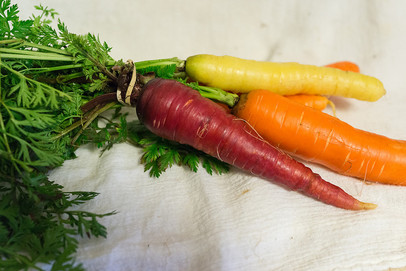
Rainbow Blend carrots is mixture of the Atomic Red, Bambino, Cosmic Purple, Lunar White, and Solar Yellow variety carrots. Each color tastes slightly different but they are all equally delicious.
This all-purpose carrot blend is excellent for eating raw, roasted, steamed, or adding to stews and soups.
Click here to read more about Rainbow Blend Carrots.
Chocolate Cherry is an intriguing heirloom cherry type tomato. This variety produces an abundance of 1" dark burgundy fruits that are extremely flavourful. We grew this tomato last year and it's definitely a keeper.
Chocolate Cherry is an indeterminate type tomato. Be prepared stake or cage the plant, as it grows rather large (4-6 feet high).
Click here to read more about Chocolate Cherry tomatoes.

On the outside, Red Meat radish is creamy white with green shoulders. On the inside, it is an unexpectedly vibrant fuchsia color. I personally prefer to think of this radish by its other, more appetizing name: watermelon radish.
Watermelon radish is smooth, exceptionally mild, and sweet. Harvest the radishes when they are 2-4" in diameter. Use the radishes on salads or as plate garnishes.
This radish is most often recommended for late summer sowing due to its tendency to bolt. However, I'm interested to try how a spring sowing will turn out, seeing as much of the available culture information usually applies to warmer climates. I will report back the results of this experiment.
Click here to read more about Red Meat radish.

Purple Vienna kohlrabi, or any kohlrabi for that matter, looks like something from the science fiction movie. Don't be misled by its alien appearance - kohlrabi has a mild flavour that pleases even the pickiest vegetable eaters.
Both the fleshy, purple globe and the tender central leaves of kohlrabi can be eaten raw or cooked. In taste and texture, raw kohlrabi is similar to water chestnuts. Raw kohlrabi tastes great on its own or with dip. Steaming, boiling, or stir-frying kohlrabi enhances its turnip flavour.
Ensure kohlrabi is harvested when it reaches about 2" in diameter. If it gets any bigger, it tends to go dry and fibrous. Slightly oversized kohlrabi is palatable if cooked but forget about eating it raw.
Click here for more information on Purple Vienna kohlrabi.
Golden Beets
| Golden Beets are another heirloom vegetable experiencing a popularity resurgence, and for good reason. These gorgeous, jewel-toned beets are delicious edible art. Golden beets do not bleed like their red counterparts, and so they combine well with other vegetables such as parsnip and potatoes. These beets are sweet, crispy, and mild. Don't overlook the beet tops either, as they are also very tasty. Eat the tops in salads or cook as you would spinach. Prepare the beet root by roasting, steaming, or pickling. Click here for more information on golden beets. |
Expand your gardening repertoire this spring and experiment with novelty edibles. You'll have fun, learn a few things along the way, and enjoy gourmet produce.
If you've got kids, introducing novelty vegetables is a ripe opportunity to grow a gardener. Get the kids involved in the planting, growing, and harvesting process. Chances are, they'll be interested in eating the bounty too.
| Hydrangea's Winning Features Hydrangeas are:
You really couldn't ask much more of a shrub. Plant breeders have invested millions into developing new hardy hydrangea varieties over the last decade. Every season, it seems that a few more varieties are brought to market, giving the home gardener ever more options. But which one is best for you? | Find a gardening topic using the search bar. Blog Categories All |
| Hydrangea Types & Characteristics The first thing you should know is that not all hydrangeas are hardy. In particular, I'm referring to the mophead hydrangeas (hydrangea macrophylla). Mophead hydrangeas are the those stunning blue and pink ones you see all over the Lower Mainland. The hydrangeas that do overwinter well here are the panicle type (hydrangea paniculata) and smooth type (hydrangea arborescens). |
Panicle hydrangeas are said to have cone-shaped flowers, but I only partially agree with that description. I would say that the cone shape may be very distinct or very vague, depending on the variety. Flower size also ranges greatly.
Smooth hydrangeas have broader, dome-shaped flowers. Flower size is more consistent (about 6-12" in diameter) between varieties.
With regard to flower colour, hardy hydrangeas are endless shades of white, pink, and lime. As the flowers age, they often take on changing tones and/or different colors.
Hardy hydrangea flower color is unaffected by the soil's pH level.
Foliage
Panicle hydrangeas have reddish, woody, sturdy stems, whereas smooth hydrangeas have green, flexible, relatively soft stems. This is because panicle hydrangeas regrow on previous season's growth and smooth hydrangeas grow anew from the ground each year.
Panicle hydrangea leaves also tend to be darker green and more leathery; smooth hydrangea leaves are lighter green and softer.
A major difference between panicle and smooth hydrangeas is their pruning requirements.
Panicle hydrangeas only need only a light annual trimming of the branch tips. (The exception to this is if you have an old panicle hydrangea that is not blooming well any more. In that case, the hydrangea will need "motivation" to bloom again. Just cut back a few of the oldest stems as low to the ground as possible in early spring.)
Smooth hydrangeas need a hard annual pruning in early spring, Cut back all stems to about
3-6" from ground level. For this reason, smooth hydrangeas are the better choice if your desired planting site is subject to heavy winter snow loads.
Plant Size
A mature hardy hydrangea can be as little as 3' x 3' or as large as 10' x 10', depending on the variety.
Usage
As demonstrated in the photo gallery below, hydrangeas can be planted as:
- a feature shrub or as a combination with other perennials/shrubs
- as a foundation planting (meaning against the foundation of a house)
- as a mass planting
- as a hedge
- as a small tree (see note below)
Note - Tree hydrangeas are simply hydrangea shrubs trained into a tree form. This process takes several years of selective pruning. If you have the patience, any hydrangea can be trained into a tree (otherwise, ready-made tree hydrangeas are available.)
Hydrangeas are easy to grow but they do need moist soil. Hydrangeas resent being dry and they will show it. If you prepare your soil properly, add mulch around the shrub base, and water deeply but infrequently, your hydrangea should thrive.
Different hydrangea varieties tolerate varying degrees of shade. Generally speaking, hydrangeas are adaptable to sites that receive a minimum of 3 hours of sun daily.
Since hydrangeas flower prolifically, fertilizing is a good idea. For the first year, only use bone meal and transplant fertilizer. After that, apply a slow-release fertilizer yearly to maximize flower production.
Recommended Varieties
I've yet to meet a hydrangea that I didn't like, but here is a broad sampling of the available varieties:
Hydrangea Paniculata 'Bombshell'
| Once you see this hydrangea in full bloom, you'll agree that it's aptly named. When flowering, Bombshell is smothered in so many blossoms that you can barely see its leaves. In fact, it produces more flowers than any other panicle hydrangea. The flowers start out white but slowly age to soft pink. Bombshell starts blooming earlier than most panicle hydrangeas and also has a longer flowering period. Bombshell is a dense and tidy little hydrangea, maturing to about 3' high and wide. |
| Hydrangea Arborescens 'Invincibelle Spirit' Invincibelle Spirit is the first (and only) pink flowered smooth hydrangea, which is why it made the list. The large, dome-shaped blossoms are produced from mid to late summer. Invincibelle Spirit is a medium sized hydrangea, eventually reaching 3-4' high and wide. |
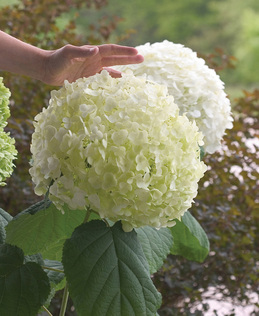
Incrediball is the new and improved version of 'Annabelle'. (Annabelle was discovered in Anna, Illinois in 1910.) Though lovely, Annabelle's blossoms tend to flop, giving the plant a messy appearance. Should a heavy rainstorm strike an Annabelle, it looks more like a tornado touched down on it.
On the contrary, Incrediball has remarkably stiff, strong stems to keep the flowers upright. And the kicker is, Incrediball's flowers are even bigger, reaching up to 12" in diameter! The flowers open lime green, turn white when fully open, and then revert back to lime green.
Incrediball grows 4-5' high and wide.
Hydrangea Paniculata 'Little Lime'
Little Lime is my latest hydrangea infatuation. We had a beautiful display of them at our front entrance last season and I couldn't keep my eyes off of them. On several occasions, I got close to admire their mesmerizing, artfully colored blossoms.
Little Lime has dense flower clusters, ranging from white to lime to pink, and everything in between. It is highly productive in terms of flowering.
Little Lime is a dwarf hydrangea, topping out at about 3' high and wide.

Hydrangea Paniculata 'Quick Fire'
Quick Fire is a valuable variety because it starts blooming one month earlier than any of the other hardy hydrangeas.
Quick Fire has a loose and airy flower shape. The blossoms emerge white, turn to pink, and eventually deepen to a cherry red.
Quick Fire is one of the largest hydrangeas, maturing to 6-8' high and wide.
Hydrangea Paniculata 'Fire Light'
2014 was only the first year we grew Fire Light. However, its unique flower color and shape makes it worthy of mentioning.
Like most pink hydrangeas, Fire Light flowers start out white and darken to a rich pink color. The flower panicles have a particularly distinct, dramatic shape.
Fire Light grows anywhere from 5-6' high and wide.
Hardy hydrangeas are exceptional flowering shrubs for our area. If you see a hardy hydrangea variety that I don't mention here, give it a try anyway. Chances are you will love it.
Check out the Proven Winners website to preview many more hydrangeas, including ones that will be released in 2016. I can't wait to try them all!
| 5 Must-Have Plants For Hanging Baskets Yes, I did arbitrarily pick the number five for this post. I had to choose something, right? Five seemed like a solid quantity for such a topic, providing neither too much or too little information. It's a reasonably digestible number. Creating this must-have list was, of course, a highly subjective task. For me, a must-have basket stuffer is one that:
So let's get to the dirt already on my 5 Must-Have Plants for Hanging Baskets. 1. Trailing Zinnia (Sanvitalia) Trailing zinnia flowers are cute as buttons (and about the same size, too!). What trailing zinnia lacks in flower size it makes up for with flower coverage. Each plant bears dozens of yellow miniature sunflower-type blossoms, which start producing early and continue until the first light frost. Although you won't see much of the foliage, it is also especially attractive. The small, hairy leaves are a deep green colour, lightly edged with burgundy. This is the kind of plant that just begs for a closer visual examination. Growing Tips Trailing zinnia likes full to part sun. It is a fairly compact grower, so choose plant companions that aren't overly aggressive. Its growth habit is advantageous if you have hanging baskets where you would rather see the pot than cover it. Plants wilt dramatically when the soil is excessively dry, but revive quickly with a good soaking. There are a few excellent sanvitalia varieties but here is the Proven Winners version: https://www.provenwinners.com/plants/sanvitalia/sunbini-creeping-zinnia-sanvitalia | Find a gardening topic using the search bar. Blog Categories All |
When we first received ornamental oregano plugs (tiny plants) a few years ago, we had no preconceived notions about them. Indeed, the plants smelled like oregano but nothing else jumped out at us....until about 8 weeks later. As it turns out, ornamental oregano is a real gem.
The foliage of oregano has unusual blue-green colouring and delicate burgundy veining. The leaves are small, leathery and quite tough.
This page has some beautiful photos of ornamental oregano: http://www.rainyside.com/plant_gallery/herbs/OriganumBarbaraTingey.html
Growing Tips
Ornamental oregano likes full to part sun. It does perfectly fine with moist or dry soil. Like sanvitalia it is a fairly compact grower, so choose plant companions that aren't overly aggressive. Its growth habit is advantageous if you have hanging baskets where you would rather see the pot than cover it.
Ornamental oregano is one of those plants that is best admired close-up. Use it in baskets hung at eye level or slightly higher.
Interestingly, this plant is rated hardy to Zone 4 so it very well might winter in the ground. We haven't tried that yet, but when we do, we will report back.
3. Illumination Begonia
Of all the plants here, illumination begonias are the belles of the ball. Their high impact blossoms are brightly coloured and ruffled, having an unmistakable femininity about them. Each plant actually has two types of flowers: the full, double male flowers and the single female flowers.

Illumination begonias thrive in full shade, part shade or part sun. Basically, they take any exposure except the hot afternoon sun (from about 1-4 pm). To keep begonias happiest, I let the soil dry slightly between waterings. They may rot if the soil is consistently wet, particularly early in the season.
It's not usually a problem in our climate, but powdery mildew fungus does occasionally affect begonias. Proper watering practices will normally prevent powdery mildew. Try to water plants in the morning/early afternoon (instead of the evening) and avoid wetting the leaves when watering.
Here is a link to the rose coloured illumination begonia but you can also peruse other series colors:
https://www.provenwinners.com/plants/begonia/illumination-rose-tuberous-begonia-begonia-x-tuberhybrida
4. Creeping Wire Vine (Small leaf Muehlenbeckia)
I first met wire vine in 2010 when I was running a greenhouse in Kamloops. It just so happened that one of my perennial suppliers had a few flats of it on his delivery truck. I honed in on this mysterious plant, as I usually do when I see something I don't recognize. Wire vine was being marketed as a perennial ground cover, but with its trailing growth habit, I thought it might work well in containers. Did it ever. A few years later we started using it in hanging baskets with equally impressive results.
Small leaf wire vine has tiny, glossy round leaves and stiff brown stems. The growth habit is unique because it somewhat stiff and yet still flowing. The stems are thread-like and really do resemble thin gauge wire. It is a medium-vigour trailer, growing about 2 feet long. Much of its beauty is in its versatility. This vine will grow in full sun to full shade and it's evergreen.
Growing Tips
Wire vine is grown for its foliage. It makes an excellent backdrop for flowering basket stuffers. Wire vine tolerates a wide range of soil conditions and grows well in full sun to full shade (although it likely gets bigger in sun.). Wire vine is one of those plants that almost every gardener has success growing.
It is worth mentioning that we recommend the small leaf muehlenbeckia over the large leaf muehlenbeckia. For whatever reason, aphids love the big leaf variety but don't seem bother the small leaf variety.
Growing wire vine also has its economical benefits because it is winter hardy. I tested this in my garden last year by planting some into the ground. Every last one survived, including the seven plants I dumped into my compost pile. So once you have this plant, you can reuse it in future seasons.
For more photos and information see:
https://www.provenwinners.com/plants/muehlenbeckia/small-leaf-creeping-wire-vine-muehlenbeckia-axillaris
5. Sangria Charm Petunia
Sangria Charm is a stand-out amongst the 100's of other wonderful trailing petunias on the market, even compared to the other Charm Series petunias.
Sangria Charm is extra special because of its little scalloped blossoms, bushy growth habit and true no-deadhead requirements. Sangria Charm does not get straggly during summer's heat nor are the flowers easily destroyed by rain.
Like other petunias, Sangria Charm likes full to part sun. It has a dense growth habit and maintains a ball-like shape. I find it pairs well with airier plants like nemesia, lobelia and verbena.
Get more information about Sangria Charm petunia here: https://www.provenwinners.com/plants/petunia/supertunia-sangria-charm-petunia-hybrid
In Summary...
I hope I've given you some dreamy new ideas for your hanging baskets. If you already grow these plants, this post is just proof of your great taste :)
We use all of these top five plants in our ready-made hanging baskets too. Come and check them out this spring if you want to see them in action.
